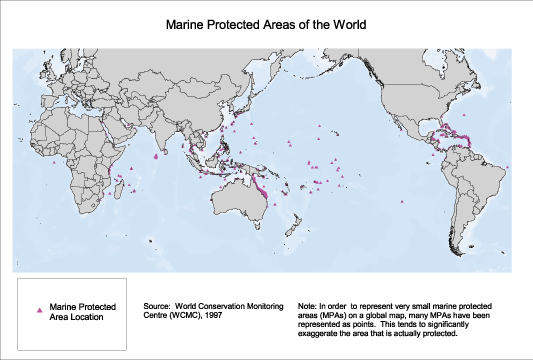MPAs: Difference between revisions
| Line 21: | Line 21: | ||
MPAs can occur on the federal, state, tribal, or international level [http://mpa.gov] | MPAs can occur on the federal, state, tribal, or international level [http://mpa.gov] | ||
MPAs were first established in the U.S. in May 2000 by Executive Order 13158 [ | MPAs were first established in the U.S. in May 2000 by Executive Order 13158 [5] | ||
== Location == | == Location == | ||
Revision as of 14:08, 27 February 2013
Marine Protected Areas (MPAs)
What are Marine Protected areas?
legally secured and set apart “to conserve biodiversity, manage natural resources, protect endangered species, reduce user conflicts, provide educational and research opportunities, and enhance commercial and recreational fisheries.”[[1]]
However, the precise definition of a Marine Protected Areas is still in debate and under review. The ICUN is working to improve the accuracy of the name in order for better consistency. Due to the vague classification Marine protected widely vary by habitats, including the open ocean, coastal areas, inter-tidal zones, estuaries, mangroves, coral reefs and Lakes. [2] Furthermore, MPA's vary widely in "conservation focus, level of protection, permanence of protection, constancy of protection, and ecological scale of protection." [3]
The definition is crucial in that it is not meant just to categorize the area, but to direct management and conservation objectives. In fact, due to lack of specificity in the definition about 50% of MPA's are considered to have been wrongly allocated. [4]
The Most recent standing Definition
MPA's were created to alleviate the negative human interaction that causes stress on marine ecosystems. These include, overfishshing or destructive fishing, coastal development,pollution and runoff, introduction of non-native species, climate change warming seas and ocean acidification.
Unlike common misconception, most MPAs are not completely closed to humans or prohibit fishing
There are several different types with varying levels of conservation and management regulations
MPAs can occur on the federal, state, tribal, or international level [5]
MPAs were first established in the U.S. in May 2000 by Executive Order 13158 [5]
Location
- How to determine location:
When selecting areas for protection of marine reserves, it is important to consider the sources and sinks, dispersal range, and metapopulations.
- Where MPa's are located:
According to estimates from the World Conservation Monitoring Centre’s Protected Areas Database, there are about 400 MPA's across the globe. This number in comparison to the terrestrial protected areas, is lacking. The amount of protection, covering less than 2% of the ocean, is not enough to combat the immense damage and stress. 150 of MPAs are less than one square kilometer in size and likely that less than 3 percent of the world’s coral reefs are protected. In fact, over 40 countries do not have any coral reef formal protection. This is important to note because MPA's work best when integrated into a comprehensive network and global cooperation that views the marine ecosystem as a whole. So far action has mainly been determined by national policy and importance.[6]
International Conventions
Effort Organizations and what they do
ICUN and the Marine and Polar Network
GOBI
Seamounts Project
UNEP
Effects of Marine Protected Areas
Studies have shown that “no take” marine protected areas, not only double the amount of fish but also their size, in a very short period of time. They also serve as safe breeding grounds for key threatened species, such as whales and marine turtles, whilst protecting a variety of marine ecosystems and the rich biodiversity they sustain. [7]
The Partnership for Interdisciplinary Studies of Coastal Oceans found in a survey of more than 100 marine reserves worldwide found a 446% average increase in biomass and a 166% increase in number of animals and plants. Also noted was an average increase in body size of sea life by 28% as well as an increase in species density by 21%[8]
Marine protected not only a recovery and conservation of a healthy ocean, they also provide a wide range of ecosystem services.
Secure human population nourishment Reduce destruction from Natural Disaster Beneficial to Tourism local governance and benefits if community managed Improve Health and alleviate poverty [9]
